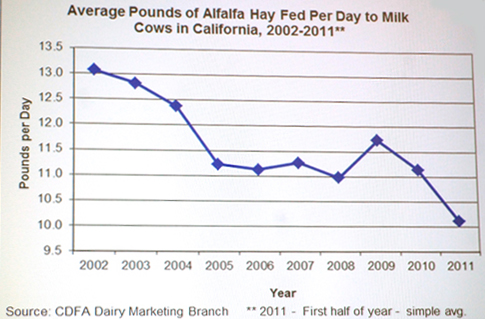High feed prices continue to dominate coffee shop dairy talk these days, with no item more discussed than alfalfa hay.
While longtime Western hay market analyst Seth Hoyt thinks prices will be $30 to $50 per ton lower during the first quarter of 2012, they won't be low in terms of what milk producers had been accustomed to for years. Compared to the sky-high prices some saw in 2011 ($300 per ton or more), even his most optimistic forecast means hay prices will be roughly double what they were less than 18 months ago.
Whether somewhat lower prices translate into more hay buying is questionable, too. While high prices haven't stopped hay from being fed to milk cows, dairy owners are gradually using less of it. Take California, the nation's largest dairy state, for instance.
As seen in the graph here that Hoyt showed at the recent Western Alfalfa & Forage Symposium, average alfalfa feeding in the state is on a lengthy and steady decline trend. California Department of Food & Agriculture data shows that milk cows in 2011 were fed an average of three pounds (22 percent) less alfalfa per head per day than in 2002.

What is taking the place of that alfalfa? Probably corn silage. During that same 2002 to 2011 period, Hoyt said total corn silage acreage in California increased from about 390,000 acres to almost 500,000. Some is likely going into ethanol, but some is just as likely going into milk cows.
While longtime Western hay market analyst Seth Hoyt thinks prices will be $30 to $50 per ton lower during the first quarter of 2012, they won't be low in terms of what milk producers had been accustomed to for years. Compared to the sky-high prices some saw in 2011 ($300 per ton or more), even his most optimistic forecast means hay prices will be roughly double what they were less than 18 months ago.
Whether somewhat lower prices translate into more hay buying is questionable, too. While high prices haven't stopped hay from being fed to milk cows, dairy owners are gradually using less of it. Take California, the nation's largest dairy state, for instance.
As seen in the graph here that Hoyt showed at the recent Western Alfalfa & Forage Symposium, average alfalfa feeding in the state is on a lengthy and steady decline trend. California Department of Food & Agriculture data shows that milk cows in 2011 were fed an average of three pounds (22 percent) less alfalfa per head per day than in 2002.

What is taking the place of that alfalfa? Probably corn silage. During that same 2002 to 2011 period, Hoyt said total corn silage acreage in California increased from about 390,000 acres to almost 500,000. Some is likely going into ethanol, but some is just as likely going into milk cows.








